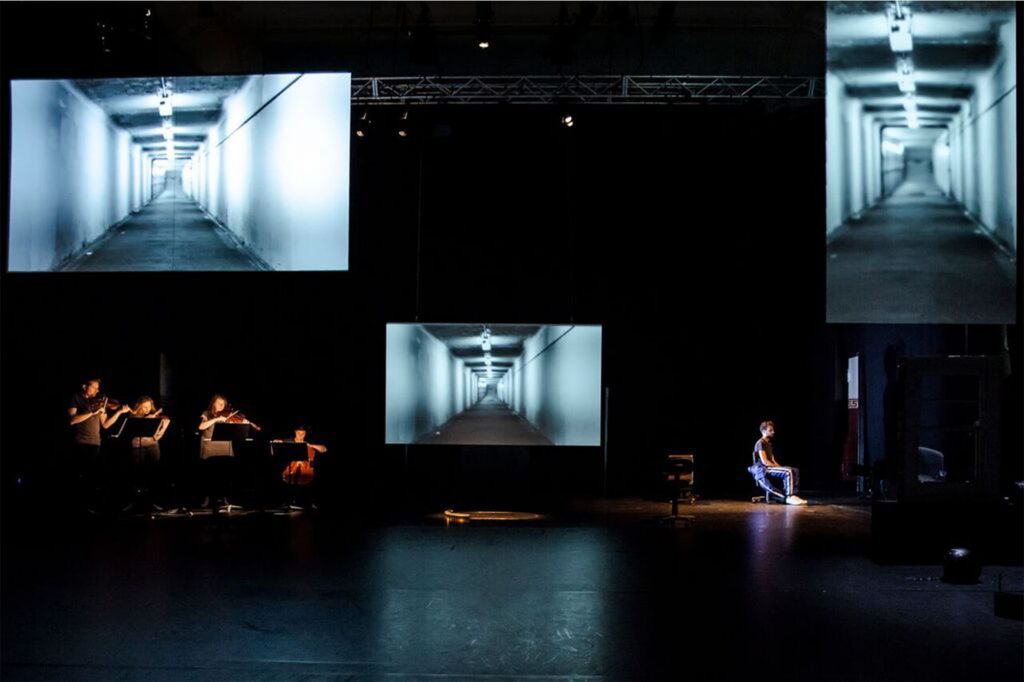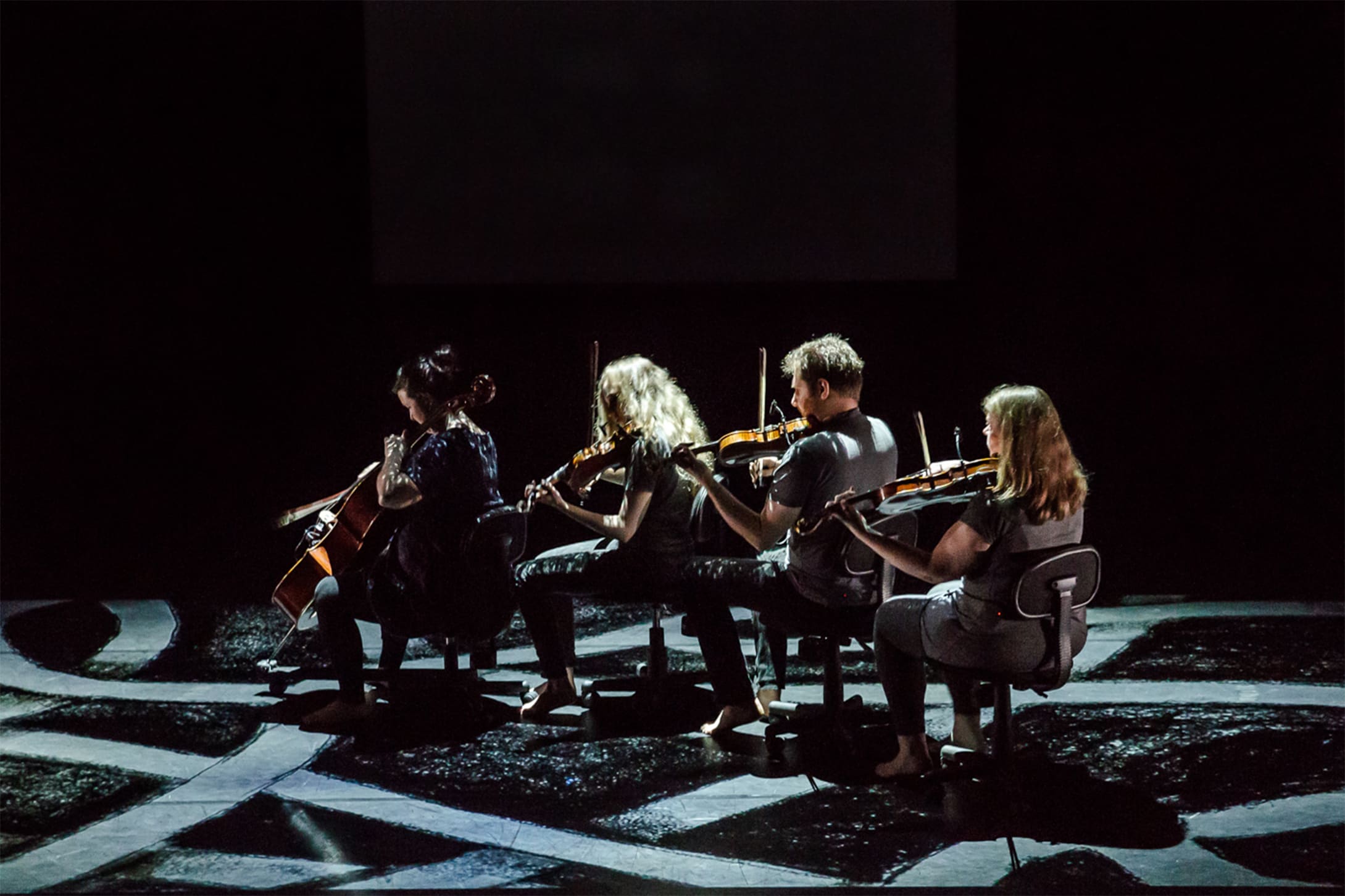
Kate Neal is an Australian artist with over 20 years experience as a composer, arranger, teacher, artistic director and collaborator. Since 2006 she has been incorporating extra-musical parameters within the notation of a musical score, such as physical gesture, design, light and choreography, providing a variety of unprecedented collisions of unlikely visual and musical cues.
For the Canberra International Music Festival 2022, Kate is presenting her ambitious collaboration with visual artist Sal Cooper, While You Sleep. Her composition unites string quartet, piano, electronics, video and animation in a surreal counterpoint of music, movement and image where nothing is quite as it seems.
Artistic Director, Roland Peelman, recently sat down with Kate to chat about her how her experiences have guided her creative direction and compositions.
Tell us about your childhood memories of the Snowy Mountains, and Cooma in particular.
I grew up in Cooma North as my parents were part of the Snowy Mountains Hydro Scheme. My two eldest sisters were born in Khancoban as Dad was a lead engineer on the Murray 2 Power Station. Mum (Laura Neal) moved to the Snowy Mountains in 1949 as an ABC reporter to cover the building and construction of the Snowy Scheme. She then wrote a substantial history book of the area ‘Cooma Country’ and established her own publication company, publishing several books documenting poems, memories and stories of the Monaro region.
We all (my 4 siblings and I) went to school in Cooma and loved it: the cold, the bleak Monaro plains, the mountains, the frost, and the Murrumbidgee River. Serendipitously, the wife of one of the engineers, Maretje Van Wezel, was an amazing musician and taught all the local children to play recorder and piano. I am so very grateful to her and Marie Cox, a local music teacher.

You studied in Holland, along with several other Australians – were you attracted to the ‘Dutch’ school, or a particular figure, or was it is just an opportunity?
I moved to The Netherlands in 1999 on a NUFFIC scholarship. I had met Louis Andriessen on an earlier trip and he was very supportive and encouraging. Dutch music had a resonance with me; this angular brutal minimalism, influenced by jazz and contemporary music, yet maintaining a rigour of form and extended harmonic language. I spent four years in Holland, and the composer Martijn Padding became an important mentor and guiding force.
You are a great collaborator, having worked with filmmakers, directors and choreographers amongst many others. Does the visual element inspire you? Or is it the human interaction and the flow of ideas that inspires?
As a music/sound person I am interested in how music is seen. This area of investigation seeks to find limits and possibilities in the physical extension of a musician’s performative practice and execution. Rather than choreography, dance or acting, there is an investigation into transmitting content on the physical body, and how notation and the memorising and translation of musical symbol, might contribute and inform this process. While You Sleep represents a major contribution to this body of research, and see’s the dismantling of the traditional aesthetic of the string quartet, as musicians’ whiz across stage on wheelie chairs, with extra-musical notation memorised to create a choreography embedded within the sonic and visual framework.
I love collaborating – working with other art forms inspires and deepens my investigation, expression and exploration of the sonic. In my long-term collaboration with visual artist/animator Sal Cooper, our cross-platform work is concerned with developing new languages to explore aspects of our human existence and articulating these discoveries through the relationship between vision and sound.

While You Sleep is not ‘pure’ music. How did it come about and what does it mean to you?
“What makes ‘While You Sleep’ exceptionally theatrical is the interlink with Cooper’s video art articulation of the fugue form, and the release of the musicians from their music stands and each other through the development. The string quartet take off, careening around the stage on office chairs, creating shapes and patterns mirroring the work in the video art, combining, dispersing, and recombining in groupings of loss and recovering just as the music is also dispersing in episodes and recombining in restatements of the subject…“
Samsara, 2018
While You Sleep represents a culmination of several years’ work, and in my long-term collaborative practice with visual artist Sal Cooper, it is our largest and most ambitious work to date. While You Sleep premiered at Arts House in North Melbourne in 2018. It is a 50minute deeply immersive and theatrical performance piece and unites string quartet, piano, electronics, video and animation in a surreal counterpoint of music, movement and image. Exploring flight, escape, memory and dissociation, While You Sleep is both contrapuntal experiment and escape from the present. Hand-drawn animation, live action, video and stop-motion are choreographed alongside the musicians on the stage.
It was interesting to us that a fugue can be two very different things: an expression of ordered precision and complexity; and also an experience of indeterminate absence (in the psychiatric ‘fugue’ state). The inherent contradiction and tension between these two very different possibilities is at the heart of this work, as is an exploration of the selective truth of memory, and the compelling possibilities of delusion. What has evolved within this work is an abiding sense of movement, a kind of wandering energy, a constant fleeing from —and return to — self and other; primary and secondary subjects.
“Cooper and Neal extrapolate a principle of aesthetic construction from the musical fugue and apply it to an expanded array of artistic materials and media. What tracks does music leave? How do we follow it as we listen to it, or recall it after we have heard it, as it erodes away in our forgetting? In ‘While You Sleep’, these questions seek answers in the visual remodulations of musical ideas, and the musical remodulations of visual ideas. What we see and what we hear intersect like two contrapuntal voices which are operating with the same basic melodic material, but which have organised it differently.”
Thomas H. Ford, 2018
